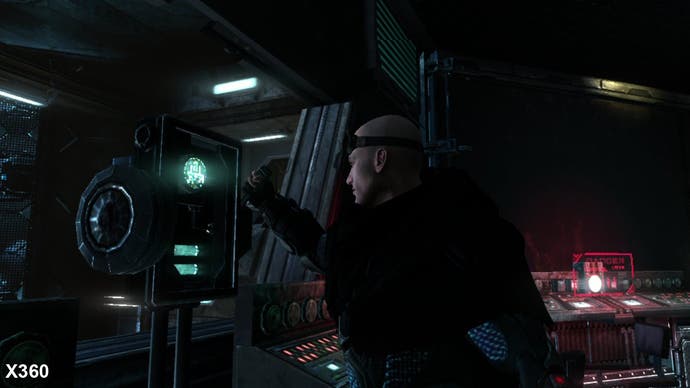Face-Off: Red Faction: Armageddon
Destruction derby.
| - | Xbox 360 | PlayStation 3 |
|---|---|---|
| Disc Size | 6.0GB | 5.7GB |
| Install | 6.0GB (optional) | 1962MB (mandatory) |
| Surround Support | Dolby Digital | Dolby Digital, 5.1LPCM, DTS |
Red Faction: Armageddon ditches the wide-open landscapes and sandbox-style gameplay of its predecessor for something altogether more linear in nature, but one particular element returns that continues to define the series: environmental destruction.
The use of Volition's GeoMod technology - upgraded to GeoMod 2.5 for this sequel - still impresses on many levels. The fact that so many elements of the environment can be obliterated adds some needed amusement to the routine shooting action that the title mainly provides. Holes can be blasted through selected walls, while floors and ceilings can collapse, and entire buildings can be destroyed. Key manmade objects can also be repaired on the fly - before being demolished again - which changes the battlefield during play.
However, these are concepts that could have been fleshed out in a far more interesting manner than they actually are. Generally speaking, things are quite tightly controlled; outside of a few select structures, much of the scenery that can be laid waste to is pretty superficial rather than central to the gameplay mechanics, being treated almost like window dressing while you blast down wave upon wave of alien antagonists.
Although this can be good fun, the gameplay soon descends into the same repetitive cycle (stop the attack, collect this object, fix that etc), broken up with cool-looking explosions and some mildly interesting uses of the game's more interesting weapon types. The core is solid, but the use of destructible environments - the aspect that makes this game unique - seems like a secondary element in the overall game design.
On a graphical level things are also equally as mixed when it comes to the visual quality of the game on both console platforms. While the graphical representation of the destruction in terms of explosive effects, particles and debris is very impressive, overall image quality seems to have been pared back in order to accommodate the engine changes - Red Faction: Armageddon runs at a lower resolution than its predecessor, Guerrilla.
First impressions of the console versions are definitely mixed. Image quality is disappointingly soft, bearing all the hallmarks of an anti-aliased sub-HD presentation: a distinct lack of fine detail is apparent, along with the 'jaggies' and some obvious edge-shimmering in places. We're basically looking at a 960x540 framebuffer on both systems - a hefty drop from the native 720p res found in Red Faction: Guerrilla, with 2x multi-sampling anti-aliasing on the 360 and the implementation of what looks like MLAA on the PS3. The difference can be examined more closely in our Red Faction: Armageddon comparison gallery.
Despite this, the results on screen aren't always as disappointing as the numbers suggest. Armageddon's use of dark, low-contrast environments in combination with anti-aliasing does help in reducing upscaling artifacts somewhat - mainly in areas where the surrounding scenery isn't made up of complex geometry. The use of MLAA on the PS3 also provides better edge-smoothing coverage, giving that version a cleaner overall appearance. But on the flip side of the coin, this comes at the expense of texture clarity, as Volition's chosen post-processing solution blurs fine detail slightly.
Red Faction: Armageddon looks accomplished enough from an image quality standpoint but not exemplary and this unfortunately funnels through to other aspects of the game's appearance. Some of the surrounding environmental structures appear quite blocky with a low polygon count, while the mixed texture work in combination with the additional upscale blur can have a negative impact on overall image quality. It ends up looking quite murky, but not necessarily for the right reasons. Regardless, there's a real sense throughout that the art is being hindered by the heavy drop in rendering resolution more than anything else - as you'll find out a bit later when we look at the PC version.




Elsewhere, and there's not really much to separate the Xbox 360 and PlayStation 3 releases from each other. We see that the bulk of the actual artwork is basically identical across the board, bar a handful of texture differences in a few places favouring the 360, where you get slightly more detail on select objects. There's also the return of lower-resolution alpha buffers on the PS3 - used for various smoke, fire and particle effects - which look like they're being rendered in an even lower resolution than they were in Guerrilla, due to the 540p framebuffer, thus amplifying any 'jaggies' when they overlap with the surrounding geometry.
In other areas we find that the 360 game is lacking the occasional light source found in the PS3 code, which serves to better illuminate the surrounding environment - lighting appears to be more ambient in nature in these areas on the MS platform. A lighting offset bias exists too, means that shadows have a tendency to protrude outwards and into view slightly more often on the PS3 at various points. But on the whole Volition has managed to create a very close looking multi-platform release on both formats.


Moving away from the usual 360 vs. PS3 comparisons for a moment, the game's cut-scenes spark a little interest. Volition has chosen to use two different types of cinematics here: one clearly using in-game assets, and the other featuring noticeably upgraded models and post processing effects, but both are presented in what looks like a similarly sub-HD resolution as the rest of the game.
The first of these is reasonably close to the PC version in terms of the level of detail on offer and improved image quality - albeit at console resolution, while the second is clearly bullshot material designed to act as a direct replacement for traditional CGI sequences. These video sequences are identical in quality on both formats, with some noticeable compression artifacts being visible in some scenes. In common with most cinematics, they run at a constant 30 frames per second, with v-sync engaged. Unfortunately, this doesn't translate to the main gameplay, as you'll see when taking a look at the performance video.
Running without v-sync and with an uncapped frame-rate on both systems, the performance aspect of Red Faction: Armageddon is a decidedly mixed affair. The game is prone to constant screen tearing and has an extremely variable frame-rate. Effectively, the developers have chosen to have the engine pump as many frames out as possible when capping at 30FPS would have improved visual consistency. The good news is that tearing isn't all that visible in every instance, despite what the results in the video might be telling you: due to the dark nature of the environments, and the lack of striking differences between frames in more quiet situations, much of the tearing goes by unnoticed. The bad news: tearing becomes very noticeable in scenes with plenty of gunfire and explosions, and in higher-contrast areas in which changes between frames are more overly apparent.









